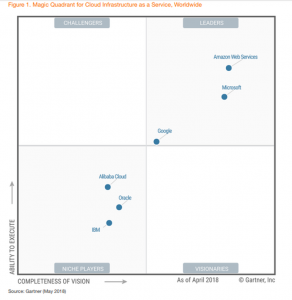Cloud Compute
AWS vs. Azure: Is There a Difference?
Article by ATI partner Danielle Hagel, Senior Manager of CoreSite’s Customer Engagement Program
Are there differences in cloud services, or is IaaS evolving into a commoditized technology? If you are considering making changes to your cloud strategy or initiating a private, public or hybrid cloud deployment, that’s an important question.
Naturally, you will look to the leading providers for an answer. For the past six years, Gartner has placed two companies in the “leaders” box of their Magic Quadrant for Cloud Infrastructure as a Service, Worldwide: Amazon Web Services and Microsoft1. Let’s put the scale of these two companies in perspective. In 2015, Gartner reported that AWS customers deployed 10X more infrastructure than the combined adoption of the next 14 providers2. Today, although Microsoft lags behind Amazon in overall use, “Azure adoption has increased significantly from 26 percent to 43 percent, reducing the AWS lead among enterprises,” according to RightScale’s 2017 State of the Cloud Report3. Looking ahead, you can expect both companies to make sharing workloads between on-premises and off-premises clouds more attractive.
AWS Services, Azure and Enterprise
If you look back only a few years, you will find that “bring IT to the forefront of the enterprise” was a common rallying cry. Now, IT is not only at the forefront, every significant decision for the enterprise includes the CTO’s input.
AWS and Azure understand this shift, and consequently the array of services they sell satisfy the business needs of their customers. A detailed comparison of AWS and Azure would reveal some differences in each provider’s service offerings. Some are subtle, such as SLA uptime guarantees or published certifications. The salient point is that the services offered address core enterprise requirements; they are business-driven, and will continue to change according to what enterprises need, not according to the cool new things that can be done with more computing power and faster networks.
Keep in mind that other players could offer services that suit your company or industry. Google Cloud Platform and SoftLayer are two examples and each differentiates themselves with niche IaaS services: Google’s services include machine learning and natural language APIs; SoftLayer offers a 100% SLA.
Again, we are not recommending either of these companies, but are illustrating the fact that the cloud is a dynamic technology with many possibilities. Come to think of it, that doesn’t sound like commoditization at all.
Article by Danielle Hagel, Senior Manager of CoreSite’s Customer Engagement Program
Cloud Compute
 2018 Gartner IaaS Report
2018 Gartner IaaS Report
Notable Takeaways
1) Amazon AWS stays on top for another year, well ahead of the pack in the Leaders quadrant2) Microsoft Azure stays strong at #2 in the Leaders quadrant
3) Google cloud on the rise and makes first appearance the Leaders Magic Quadrant
4) Alibaba Cloud is now a global player for those looking for something similar to AWS but perhaps at a lower price point
5) 8 vendors most notably Rackspace, dropped out for their inability to support large scale workloads
6) The marketplace seems to have almost completed their consolidation in the IaaS space
Learn more about IaaS here, and don’t hesitate to contact ATI to learn more.
